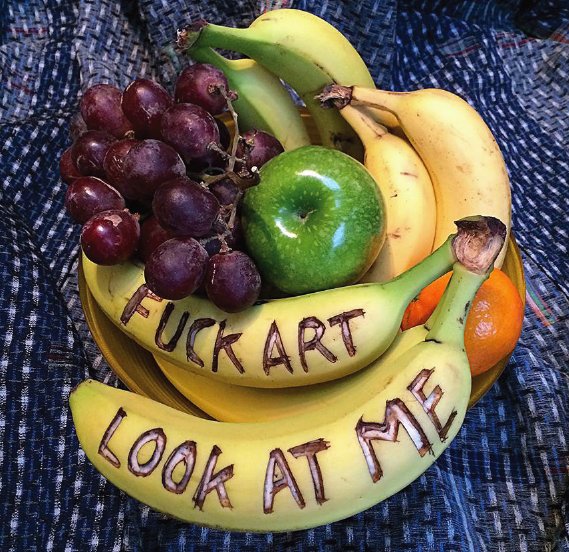
Quarter #6 Interview: Graeme Messer
Graeme Messer is a painter, a sculptor, an actor, director, writer, and puppeteer, but he’s also something of a magician. Oft overlooked everyday objects in Graeme’s hands become something other; a crucial part of a mixed media assemblage, redolent with childhood memories and candid wit. Broken televisions, doll parts, photos, and old furniture are all incorporated into his unconventional menagerie, forming a collection that is all at once playful, dark, refreshingly droll, and never short of intriguing. The Quarter joined Graeme in his Chocolate Factory studio for an insight into his fascinating solo show at Karamel, The Art of Love and How to Avoid It.
So, is love something you’re trying to avoid? What gave you the idea for the title?
I guess it’s a joke, a bit of a pun. You know you get books such as “The art of love”, the art of this, the art of that. Its playing with that idea. It’s not really about how to avoid love as much as it’s about how we spend so much time running away from something that we really want. It’s a paradox, really.
The work in this exhibition touches on a lot of quite personal themes. When you start a piece, do you go in with the intention of creating something that addresses those themes, or is that something that comes out during the process?
A lot of my work is very autobiographical, I’ve got a history of working in theatre, I worked as a theatre director for 20 years, writing and directing plays. We used to work almost like Mike Leigh does – working with a very autobiographical process. We would work with people’s own history, their own… stuff and try to create plays and characters from that.
Whatever I’m dealing with in my life comes into the work. It may be something like intimacy or the difficulties and struggles with intimacy. Things often lead me back to my childhood, a lot of my work is about the fact that what happens to us in childhood is often impacting on
what happens to us later in life and the question “can you ever escape from those formative years?” Sometimes the memories can be rather funny or sometimes quite traumatic.
As a multidisciplinary artist, how do you select the best avenue to express a particular idea or emotion?
What really happens is, I get a certain idea or feeling that I want to express, and then the medium might be film, it might be something that’s theatrical, like an object I wear, the medium sort of dictates itself. I’ve worked in so many areas – theatre, writing, painting, sculpting, so there’s a lot to draw from and I never really know what will take precedence. It’s the idea that leads me to the medium, more than the other way around. And as soon as I decide, which I‘d love to do, that this is the medium I want to work with, that changes.
I work a lot with found objects. What’s fantastic about being here in the Chocolate Factory, is that half of the stuff I have here is stuff I found in the skips; bits of metal, there’s a television that’s almost identical to this one (gay news) in a skip downstairs that I’m considering getting. Very often I walk around to the junk shops, second hand shops and I find things, like I found some old bowls which reminded me my grandfather used to play bowls in South Africa, a very long time ago, so I built a whole piece around these objects about him. I’ll very rarely stand in front of a blank canvas and think ‘what am I going to paint? ‘I’m triggered much more by what’s around me.
You mentioned South Africa there, how much influence would you say that has on your work?
I grew up under apartheid in SA, I went to a government school, it was all about rugby and football. It was a very outdoors, macho environment……. I started to realise I was different, I had red hair, I felt strange, …… and then later….. having feelings of maybe being gay. I needed to find a different way of showing my strengths and my abilities. So, I did art a lot, and I also used to do puppet shows and ventriloquism, I used to take my puppets to school and entertain the class, and I found my own little ways of competing… Anything that no one else was doing
Actually I remember, at first I was the only person at school that did ventriloquism, but then someone else started to do it, and I kind of lost interest in it after that, because I wasn’t the only one anymore.
But you do still dabble in performance, though?
Yes there is actually quite a lot of performance in “The Art of love”. Sometimes I use puppetry in my work and sometimes my physical theatre background come into play.
What made you want to move away from theatre and focus more on fine art?
I just never really felt like I had that much of a voice in theatre or was really able to express myself entirely. It felt, and this is not the case for everybody, that I was using plays written by other people to try and express myself and it never quite worked. It did with some productions, some that I wrote. But generally It felt like here was something missing, that I needed something more immediate, more personal.
I think what is quite interesting about what I am playing with now, is the idea that something can exist as a piece of art on a wall, but can also have a performance element to it. I think that if you can have those things working at the same time, as opposed to being purely about the performance or purely about the art, that’s very interesting.
Having all those elements must really add to the accessibility, which is something I know you’re interested in…
I think is great when almost anybody who comes off the street can relate to the work. I think that’s probably also to do with my theatre background to some extent – wanting to communicate, wanting to hold people’s attention. I think with a lot of contemporary art, there’s an idea that if it doesn’t really communicate anything or if it’s a bit boring, that’s fine, whereas in a theatre, because you have people there for two hours or so, if it’s boring, if it’s not communicating anything, they just walk out. So I think there is that background sense of urgency for people to get what you’re saying and if they don’t they just walk away.
The competition piece seems to have sparked quite a lively debate on Pink News’ website, which you’ve been linking to through your twitter. What do you make of all that, particularly your ‘detractors’ if you like?
I sent out the article to a few places and they published it very quickly, and within seconds there were comments like ‘this is a load of rubbish’, or whatever. I’ve had some quite tough experiences in the theatre, but this just felt like, ‘wow, is this what it’s going to be like?’ It’s quite ironic actually because the whole point of the competition is to raise money to combat homophobic bullying in schools and this really felt like a bullying kind of attack that was quite abusive. First of all, you have to accept that the internet is what it is. These are anonymous people just immediately going on to a website and saying whatever they’re going to say, but
actually it was really good because it sparked the debate and now there are about 20 or so really quite long posts defending my work and speaking against some of the nastier comments, which is great. But anyway, in the contemporary art world, it’s absolutely fine for someone to say ‘this is rubbish, I think this is junk’. And I think that argument is good, I think it’s a good thing to get people talking about something. And there will be people who look at a contemporary work of art, and think it’s not in a conventional sense what painting should be, you’re not representing something in an obvious way and that the time, or effort, or technique is not immediately on show. Some people just don’t get that its more about ideas and concepts, it’s not for them, which, again, is fine.
It must have been surprising though, given the nature of the website, that there was such resistance?
I think you have to accept the fact that some people love what you do, and some people may hate it. It’s far more interesting for that to be the case than everybody thinking it’s sort of ok.
How do you select the words you use in your work? Is it similar to your process with found objects, where phrases have a particular resonance, or is it more you want to express an idea and have to find the best way to do that?
I was working with objects when I suddenly realised I could put words on things, that made it come to life in a really different way. But it’s quite tricky, people aren’t going to stand there for ages reading some long spiel, so it has to be quite punchy, it’s almost like an advert in a sense, and yet it also needs to be quite poetic. It very often sounds like I’m speaking, ‘my mother took my gay news rather well’ ‘I’ll do anything for love and approval. Anything.’ It’s almost like a play in a sense, like someone speaking directly to an audience. The difficulty sometimes is how it fits onto the actual piece. I’ve never wanted to apologise for the writing,
sometimes it takes up as much focus as the piece does, so it can be tricky, you have to fiddle around with it and rewrite it. It’s just a question of playing around with different words and phrases. I’m forever putting things on, taking them off and rewriting them. It’s a sort of alchemy, you have to find the balance of what works and, quite often- it doesn’t. So you have to fiddle around with it and do it again.
Are there any techniques or media you’re keen to try but haven’t yet?
Maybe some work with film, it’s very difficult to actually film a video of yourself, so I’d be interested in working with somebody. The other thing right now, is actually wanting to work quite big. It’s tricky, but I’d like to create large pieces that I could climb into or onto in some way, to paint them, then to be able to interact with them. I don’t know the way you’d go about it yet, you’d have to create quite a solid structure. It would have to be supported in some way that so I could get into or on top of it. Perhaps in the future.
Sounds Fascinating, Graeme! We look forward to it.
Graeme Messer’s solo exhibition at Karamel is from March 16th – May 1st
Read the latest issue of Quarter here!
Download a copy here

